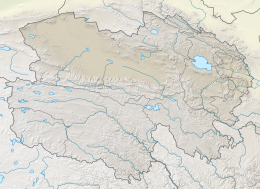2022 Qinghai earthquake
 | |
  | |
| UTC time | 2022-01-07 17:45:30 |
|---|---|
| ISC event | 621668769 |
| USGS-ANSS | ComCat |
| Local date | 8 January 2022 |
| Local time | 01:45 CST (UTC+8) |
| Magnitude | 6.6 Mw(USGS) 6.7 Mw(GeoAU) [1] |
| Depth | 13 km (8.1 mi) |
| Epicenter | 37°48′40″N 101°16′30″E / 37.811°N 101.275°ECoordinates: 37°48′40″N 101°16′30″E / 37.811°N 101.275°E |
| Fault | Haiyuan Fault |
| Areas affected | China |
| Max. intensity | VIII (Severe) |
| Casualties | 9 injured |
On January 8, 2022, a magnitude 6.6 earthquake struck Menyuan County, Qinghai Province near the border with Gansu Province, China.[2][3][4] It was the largest earthquake in China since the 2021 Maduo earthquake.[5]
Tectonic setting[]
The earthquake was located close to the northern margin of the Tibetan Plateau. This area of thickened crust is a result of the ongoing collision of the Indo-Australian Plate with the Eurasian Plate.[6] The way in which this zone accommodates the collision remains unclear with two end-member models being proposed. The first regards the crust as being made up of a mosaic of strong blocks separated by weak fault zones, the microplate model. The second regards the deformation as being continuous within the mid to lower crust, the continuum model. The change in width of the deformed zone along the collisional belt, with the narrow zone of western Tibet compared to the main part of the Tibetan Plateau, is explained as either lateral escape to the east along the Altyn Tagh and Karakorum faults in the microplate model or as the effect of the rigid Tarim Basin block causing heterogeneous deformation within a generally weaker lithosphere in the continuum model.[7] At its northern end, the Altyn Tagh fault progressively loses displacement by its interaction with a series of WNW–ESE trending structures, mostly with components of reverse displacement and sinistral (left lateral) strike-slip. The Changma fault is one of those structures.[8]
The earthquake was followed by eight aftershocks: "one of magnitude 5.0 to 5.9, two of magnitude 4.0 to 4.9, and nine of magnitude 3.0 to 3.9." The largest aftershock was of magnitude 5.1.[9][10]
Damage and injuries[]
| Modified Mercalli intensities in selected locations[11] | ||
| MMI | Locations | Intensity felt by |
|---|---|---|
| VIII (Severe) | Menyuan | 3,000 |
| VII (Very strong) | Huangcheng | 9,000 |
| VI (Strong) | Obo Qingshizui |
92,000 |
| V (Moderate) | Zhangye Wuwei |
1.7 million |
| IV (Light) | Xining Yinchuan Lanzhou |
19.8 million |
| III (Weak) | Xi'an Tianshui |
55.3 million |
The earthquake damaged at least 137 homes and collapsed two walls in Zhangye.[12] Four people in Menyuan Hui Autonomous County suffered minor injuries while evacuating.[2] In total, nine people were reported to be injured, eight of them were discharged from hospitals by the following day.[9]
Some bridges and tunnels on the Lanzhou–Xinjiang high-speed railway sustained serious damage and traffic was halted until repairs could be completed.[13] The Great Wall of China was also damaged by the quake. A 2 m (6 ft 7 in) section of the wall in Shandan County collapsed. The section that collapsed was built during the Ming Dynasty. Repair and restoration work has already begun at the scene of the incident.[14]
See also[]
References[]
- ^ "Earthquake Details: Gansu, China". earthquakes.ga.gov.au.
- ^ a b "青海门源发生6.9级地震 4位民众避险时受轻伤" (in Chinese). Economic Daily. 8 January 2022. Retrieved 8 January 2022.
- ^ "青海门源6.9级地震致明长城山丹段约两米墙体发生塌损".
- ^ "Strong earthquake shakes remote area in western China". The Independent. 8 January 2022. Retrieved 8 January 2022.
- ^ "M 7.3 - Southern Qinghai, China". earthquake.usgs.gov. Retrieved 21 May 2021.
- ^ "徐锡伟院长接受《中国科学报》采访解读青海门源6.9级地震 - 院内动态 - 应急管理部国家自然灾害防治研究院". www.ninhm.ac.cn. Retrieved 11 January 2022.
- ^ Cowgill, E.; Yin, A.; Harrison T.M.; Xiao-Feng, W. (2003). "Reconstruction of the Altyn Tagh fault based on U-Pb geochronology: Role of back thrusts, mantle sutures, and heterogeneous crustal strength in forming the Tibetan Plateau" (PDF). Journal of Geophysical Research. 108 (B7): 2346. Bibcode:2003JGRB..108.2346C. CiteSeerX 10.1.1.458.2239. doi:10.1029/2002JB002080. Archived from the original (PDF) on 18 July 2010. Retrieved 3 November 2010.
- ^ Meyer, B.; Tapponnier, P.; Bourjot, L.; Métivier, F.; Gaudemer, Y.; Peltzer, G.; Shunmin, G.; Zhitai, C. (1998). "Crustal thickening in Gansu-Qinghai, lithospheric mantle subduction, and oblique, strike-slip controlled growth of the Tibetan plateau". Geophysical Journal International. 135 (1): 1–47. Bibcode:1998GeoJI.135....1M. doi:10.1046/j.1365-246X.1998.00567.x.
- ^ a b "青海门源6.9级地震 地面剧烈晃动!12余次余震 近6000人受灾!监控视频现地震前耀眼强光 什么情况 _ 东方财富网". finance.eastmoney.com. Retrieved 10 January 2022.
- ^ "M 5.1 - 126 km SW of Jinchang, China". earthquake.usgs.gov. Archived from the original on 18 February 2022. Retrieved 27 January 2022.
- ^ "PAGER" (PDF). USGS. 8 February 2022. Archived (PDF) from the original on 18 February 2022. Retrieved 18 February 2022.
- ^ Yang Li, ed. (8 January 2022). "受地震影响 甘肃张掖137户房屋出现裂缝" (in Chinese). The Beijing News. Retrieved 8 January 2022.
- ^ "青海6.9级地震致兰新高铁受损严重,西北多条铁路运行受影响|界面新闻". www.jiemian.com (in Chinese). Retrieved 10 January 2022.
- ^ "The part of the Great Wall of China collapsed due to earthquake". turkmenportal.com. Retrieved 27 January 2022.
- 2022 earthquakes
- Earthquakes in China
- Earthquakes in Gansu
- January 2022 events in China
- 2022 disasters in China
- History of Qinghai


